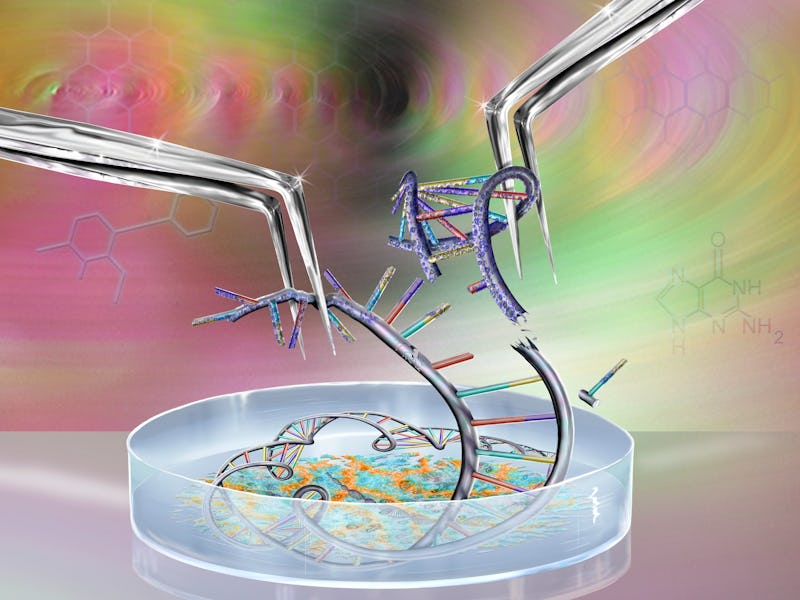This CRISPR tool costs $10,000. Researchers made a version that costs 23 cents
The ElectroPen could revolutionize a high school classroom near you.

In microbiology, an electroporator is a tool that allows scientists to apply electricity to a cell to temporarily breach its cell wall so you can introduce chemicals, drugs or DNA to the cell. These tools are extremely useful in the lab, but they’re also very expensive. They cost anywhere from roughly $3,000 to $10,000.
Researchers at Georgia Tech just revealed they’ve found a way to create an electroporator that costs next to nothing to make. Their research was just published in the journal PLOS Biology.
These researchers were able to create a version of the electroporator that can generate short bursts of more than 2,000 volts of electricity, which they named the “ElectroPen,” using a crystal from a common lighter, copper-plated wire, heat-shrinking wire insulator and aluminum tape. They then created a case for these components using a 3D printer. They claim you can assemble it within 15 minutes once you have all the pieces.
They used the piezoelectric crystal from the lighter as a power source, after trying multiple different types of crystals to generate the right amount of electricity, because it was the best at producing a consistently-high voltage while they were testing out the device.
This low-cost version of an electroporator isn’t meant to be used for sophisticated research, but the researchers believe a tool like this could be useful for training students at high schools and universities and for people who work in “remote locations without access to electricity to perform experiments or processes involving electroporation.”
The researchers were able to test the device on samples of E. coli. They breached its cell walls and were able to introduce a chemical to the E. coli cells that make them fluorescent under special lights, which makes different cell parts easier to identify.
See also: How CRISPR Gene Editing Trials on Humans Were Finally Approved in the US
Saad Bhamla, an assistant professor in Georgia Tech’s School of Chemical and Biomolecular Engineering and one of the authors of the study, tells Inverse that this device could be used for more than just high school and college biology studies. It could also be used by anyone else who wants to use the tool to do something like genetic engineering with CRISPR or for drug delivery. However, these researchers haven’t tried using it for that.
“We haven’t tested it with mammalian cells,” Bhamla says. “To make that leap, you’d have to do much more testing.”
Georgia Tech undergraduate student Gaurav Byagathvalli and assistant professor Saad Bhamla and their ElectroPens
So how cheap would it be? Bhamla says that the parts that are required to make the device would cost only 23 cents. That’s quite a bit cheaper than spending thousands of dollars. He notes that the lighter that this device is based on can be bought at pretty much any corner store in the world for very little money.
Bhamla describes the work his lab does as “frugal science.” He says they’ve done a lot of work that focuses on how you can make versions of expensive devices incredibly inexpensive. Their next project will focus on how you can make a hearing aid for only one dollar.
>Abstract:
Electroporation is a basic yet powerful method for delivering small molecules (RNA, DNA, drugs) across cell membranes by application of an electrical field. It is used for many diverse applications, from genetically engineering cells to drug- and DNA-based vaccine delivery. Despite this broad utility, the high cost of electroporators can keep this approach out of reach for many budget-conscious laboratories. To address this need, we develop a simple, inexpensive, and handheld electroporator inspired by and derived from a common household piezoelectric stove lighter. The proposed “ElectroPen” device can cost as little as 23 cents (US dollars) to manufacture, is portable (weighs 13 g and requires no electricity), can be easily fabricated using 3D printing, and delivers repeatable exponentially decaying pulses of about 2,000 V in 5 ms. We provide a proof-of-concept demonstration by genetically transforming plasmids into Escherichia coli cells, showing transformation efficiency comparable to commercial devices, but at a fraction of the cost. We also demonstrate the potential for rapid dissemination of this approach, with multiple research groups across the globe validating the ease of construction and functionality of our device, supporting the potential for democratization of science through frugal tools. Thus, the simplicity, accessibility, and affordability of our device holds potential for making modern synthetic biology accessible in high school, community, and resource-poor laboratories.
Figures